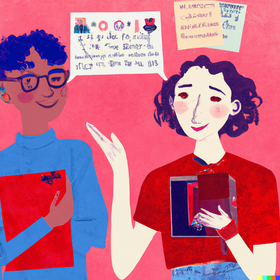Engaging with theoretical, empirical, and critical research into language, writing, power, identity and so on is critical to being successful and effective tutors. You get new insights into our work and find new and better ways to connect theory and research findings to practice—your practice. Five readings directly examine working with EAL writers and writing and the final three readings consider work with multilingual writers with a focus on Black Language and Black Lives and the important role tutors play in dismantling "standard" English practices that are rooted in and perpetuate white supremacy. The theories and ideas presented within them cover a wide range of practices, situations, and considerations that will help you become a more effective EAL tutor and a more just and anti-racist tutor.
Scholarship
“Breaking Ice and Setting Goals: Tips for Getting Started” Shanti Bruce
Article Overview
This chapter of ESL Writers: A Guide for Writing Center Tutors (2009) written by Shanti Bruce focuses on how writing center tutors can actively welcome EAL writers into the writing center space and into a session. It is often even more challenging for EAL writers to feel comfortable beginning a tutoring session, which Shanti Bruce explains often comes from feeling intimidated or judged by tutors. Thus, this chapter serves as both an introduction and a refresher for approaching face-to-face appointments with EAL writers and provides strategies for making EAL writers feel welcome at the start of the tutoring session. Further, this chapter serves as a helpful reminder of the feelings an EAL writer may have about coming to the writing center and that our job as tutors is not to evaluate or judge a writer’s English writing or speaking ability.
Article
“Reading an ESL Writer’s Text” Paul Kei Matsuda, & Michelle Cox.
Article Overview
Also read in the WRD writing center pedagogy training course, this Matsuda and Cox (2011) article helps tutors understand that the differences in an EAL writer’s writing aren’t deficiencies. Further, the article provides approaches for working with those differences and even provides insight on how to capitalize on them in a tutoring appointment in a way that benefits the writer. The key takeaways from the article are the various approaches that can be used to read EAL writers' writing. These approaches are the assimilationist stance, the accommodationist stance, and the separatist stance. If you are a returning tutor who has not read this article in a while, it’s a great refresher on the various strategies that can be used to work with EAL writers’ writings that will help vary your sessions from writer to writer.
Article
“The Speaking-Writing Connection in Second Language and Academic Literacy Development” Jessica Williams
Article Overview
Published in The Oral/Literate Connection: Perspectives on L2 Speaking, Writing, and Other Media Interactions (2009), William's chapter explores the growing research on two hypotheses: 1) L2 (second language) speaking facilitates the acquisition of L2 literacy, and 2) L2 writing impacts the development of L2 proficiency. In the UCWbL these forms of literacy development are directly applied in standard writing appointments as well as in our Conversation Partner appointments. If you’re ever wondering about the significance of the Conversation Partner modality as a way to enhance English writing skills, this is a great article to reference.
Article
“’Eye’ Learners and ‘Ear’ Learners: Identifying the Language Needs of International Student and U.S. Resident Writers.” Joy Reid
Article Overview
Reid’s article was published as a chapter in Grammar in the Composition Classroom: Essays on Teaching ESL for College-Bound Students (1998). In this article, Reid discusses the complex identities of EAL and multilingual learners that exist in schools and how their writings may differ. Reid defines those who acquired English language knowledge through listening as “ear learners” while those who learned English through studying, reading, and writing with a strong focus on the structure of the language as “eye learners.” What’s important to consider given the rising diversity of academic institutions is that these two types of learners may not necessarily identify as EAL learners. For example, a person whose parents both are native Spanish speakers but also speak English most likely grew up learning both languages in the household simultaneously might identify as a native English speaker. As writing tutors, we must consider the complex identities of writers and not assume that all EAL and multilingual writers have the same background in English language acquisition.
Article
